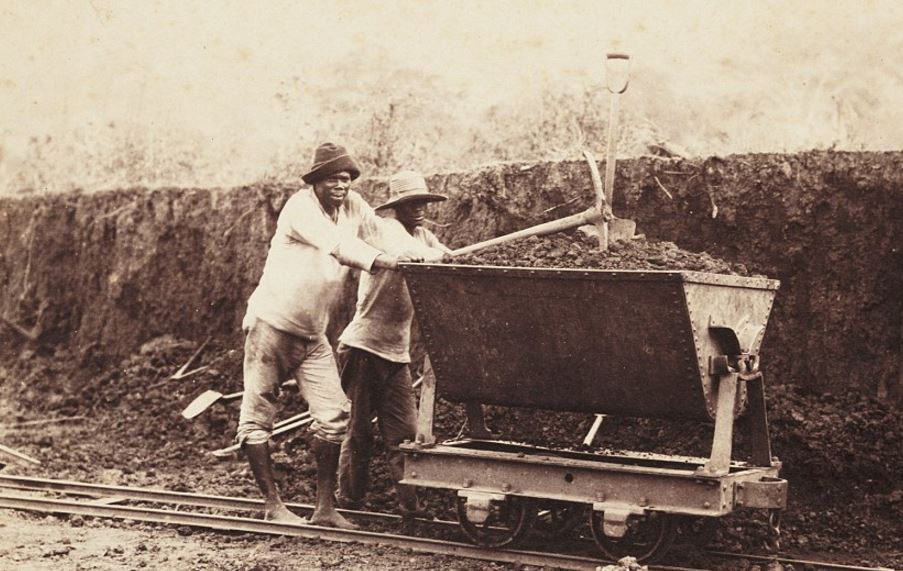The Panama Canal is Doing Quite Well
As a historian, it gives me a jolt of joy when a president has a firm grasp of history. We saw that earlier this week when President Trump met with the president of Panama, Juan Carlos Varela.
The American president quipped:
"The Panama Canal is doing quite well. I think we did a good job building it, right — a very good job."It was the Panamanian president's response that made me smile:
"Yeah, about 100 years ago."It's nice when a president has a firm grasp of history.
| President Varela of Panama and President Trump. Prensa Latina |
Some on the Internet are having fun and saying President Trump gaffed by taking credit for building the canal, but they could be making something out of nothing. He never actually stated that he's responsible for it.
Regardless, it doesn't hurt to review how the canal came to be . . . yes, about a hundred years ago.
The idea for a canal across Panama came long before the United States was involved, or even existed. The first known mention of a canal came in 1534, when Spanish king and Holy Roman Emperor Charles V decreed that a route be surveyed across the isthmus. When the survey was completed, the Panamanian governor opined it would be impossible to build.
| Charles V of Spain. |
In 1668 the English weighed in when Sir Thomas Browne wrote:
"Some Isthmus[es] have been eat[en] through by the Sea, and others cut by the spade: And if policy would permit, that of Panama in America were most worthy the attempt: it being but few miles over, and would open a shorter cut unto the East Indies and China."Five years after American Revolutionary War, Thomas Jefferson piped up and said the Spanish should take it on. Nothing came of it.
The first actual shovel in the ground was plunged by the French, who thought they could replicate their roaringly successful Suez Canal in Egypt. However, they hadn't accounted for Panama's rainy season, venomous snakes, insects and spiders, and malaria and yellow fever. After spending $287,000,000 and losing 22,000 lives, the French gave up.
It was then the U.S.'s turn to give it a try, so it purchased the venture from the French. Panama was controlled by Colombia at the time, but word drifted to President Theodore Roosevelt's ears in 1903 that Panamanian rebels were planning to break away. Sensing opportunity, Roosevelt sent ships down to block Colombian troops and allow Panama to declare independence.
The U.S. immediately recognized the new nation and signed a treaty to build and administer the canal. No Panamanian was present at the signing. The New York Times called it "an act of sordid conquest." The New York Evening Post called it a "vulgar and mercenary venture."
| A political cartoon showing President Roosevelt dumping canal soil on Colombia. |
U.S. efforts were much more successful and efficient than the French's, which included a massive effort to rid the area of malaria-bearing mosquitoes. Still, 5,600 workers died during the project from disease or accidents.
But when President Trump claimed, "We did a good job building it," he is correct; the canal was finished in 1914 and is still vital to commerce today. However, far more Caribbeans, southern Europeans, Indians and Panamanians than Americans labored to see the project through.
 |
| Panamanian workers laboring on the canal. |
Julie Greene explains:
"All these workers, particularly those from the Caribbean, confronted a harsh working environment, including possible jail time or deportation if they failed to show up for work, high rates of disease and workplace accidents, and a pervasive system of racial segregation seeking to keep them under control."The completed canal was toasted at the 1915 Panama Pacific International Exposition in San Francisco. Panama's representative, Don Lefevre, was polite but not jubilant. He exhorted:
"We should not forget the important share that Panama and its people have taken in this unparalleled undertaking. We have had our territory pierced in two through the powerful arm of Uncle Sam."
| Laborers excavate Panamanian soil using giant steam shovels. |
The U.S. turned over control of the canal to Panama in 1999, and Panama has just last year completed an expansion to allow more and larger ships to pass through. Since 1914, it's been estimated that more than 815,000 ships have passed through the canal's locks.
So if President Varela really knew his history (to say nothing of President Trump), he should have responded, "Yeah, we did do a good job!"
| Panamanians celebrate at the canal transfer ceremony on December 31, 1999. AP |
I am currently working on a book about Ah Toy, the first Chinese brothel madam in gold rush San Francisco.
Want to read more? Click "Subscribe." Please share this post and your comments.
Comments
Post a Comment